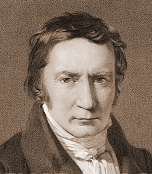Finnur Magnússon
Finnur Magnusson (Danish also Finn Magnusen ; born August 27, 1781 in Skálholt , Iceland, † December 24, 1847 in Copenhagen ) was an Icelandic philologist and archivist .
Life
Finnur's parents were the episcopal estate manager in Skálholt, Magnús Ólafsson, and his wife Ragnheiðr Finnsdóttir, daughter of Bishop Finnur Jónsson in Skálholt.
On November 6, 1821 Finnur he married Nicoline Barbara Dorothea Frydensberg, daughter of the Judicial Council Frydenberg in Kalundborg, who had been his superior as city and country bailiff in Reykjavík. The marriage was divorced in 1836.
After a severe earthquake in 1784 had almost completely destroyed the bishopric of Skálholt, the parents moved to the Meðalfell farm, where he received private lessons from his uncle, Bishop Jón Finnson . He then went to Copenhagen, where he passed the Examen artium in 1798. He studied law. He received a scholarship from the Arnamagnæan Foundation in Copenhagen, but had to return to Iceland on the occasion of the death of his father in 1800. He stayed there for eleven years. In 1803 he became a representative of the mayor of Reykjavík, and in 1806 he was also a lawyer at the local high court. He also tried his hand at writing from 1800 and wrote some poems that he published in a collection. He used the Danish and Icelandic languages equally. He also edited the magazine Minnisverd Tídindi and submitted the translation of a smaller saga to the Arnamagnæan Commission.
In 1809 the adventurer Jørgen Jürgensen , known as the "100-day king", came to Iceland and took over rule on June 25, 1809, which came to an abrupt end with the intervention of an English warship in mid-August. Finnur Magnússon resisted the request to participate in the new government, which later earned him the goodwill of the king. In 1812 he traveled to Copenhagen. In 1815 King Friedrich VI appointed him. as adjunct professor.
In 1818 he completed work on the Sæmundur Edda (translation and commentary) with a two-volume work. In 1816 he began lecturing on the oldest Nordic literature and mythology. During this time he wrote the two works Den ældre Edda Vol. I-IV (1821–23) (Copenhagen) and Eddalæren og dens Oprindelse I – IV (1824–26). There was also the mythological work Sæmundar Edda in three volumes (1828), which contained a mythological lexicon "Priscæ veterum Borealium mythologiæ lexicon" and a pagan calendar "Calendarium gentile". He produced a version of the Edda that could be read by Danes. But his explanations were very speculative and assumed that the gods were essentially natural deities and based the individual myths on natural phenomena, especially astronomical observations and their astrological interpretation. Unfamiliar with etymology, he brought Odin and Buddha together and developed relationships not only between Buddhism and belief in Aes, but also with Greek philosophy and the Orphic mysteries.
In 1816 he became a member of the "Commission for fædrelandske Oldsagers Bevaring" (Commission for the preservation of patriotic monuments) and a founding member of the Icelandic Literature Society, for which he was the editor of the cultural magazine Skírnir, which is still published today . In 1822 he became a member of the Arnamagnæan Commission and in 1829 its secretary. In 1828 he became deputy chairman of the "Kongelige nordiske Oldskriftselskab". The connection between this society and his membership in the preservation of monuments brought him to numerous publications in professional journals. In 1829 he became a secret archivist with the title Etatsrat and actively supported Rasmus Rask in this office . With him he published the Fornmanna sögur VIII – X and produced the Danish translation of the Oldnordiske Sagaer VI – X. His contribution to the important source text Grønlands historiske Mindesmærker I – III (1838–1842) is of lasting importance , although there are also untenable explanations there. He was also chairman of "Det islandske litterære Selskab" until his death.
Among his mistakes, one became particularly famous because he kept the professional world in suspense for a long time: he had begun to study runic inscriptions, but his knowledge in this area remained limited. The mineralogist Johann Georg Forchhammer believed he had found the characters on the basalt rock there in Blekinge in 1833, which Saxo Grammaticus had reported on in his Gesta Danorum. Finnur inspected the lines, concluded that they were runes, read and translated them. In 1834 a first preliminary communication appeared and in 1841 its translation in the Scientific Society under the title Runamo og Runerne . This discovery caused a sensation in European experts, until in 1844 Worsaae proved that it was a matter of normal glacial rock grooves.
literature
- Dansk biografisk Lexicon Vol. IX. Copenhagen 1897. p. 57-
Notes and individual references
- ↑ The "Examen artium" was the regular entrance examination for university, which required knowledge of Latin and Greek. So it corresponded to the Abitur, but was accepted by the university.
- ^ Gesta Danorum, preface on Wikisource .
| personal data | |
|---|---|
| SURNAME | Finnur Magnússon |
| ALTERNATIVE NAMES | Finn Magnusen |
| BRIEF DESCRIPTION | Icelandic archivist and philologist |
| DATE OF BIRTH | August 27, 1781 |
| PLACE OF BIRTH | Skálholt |
| DATE OF DEATH | December 24, 1847 |
| Place of death | Copenhagen |

